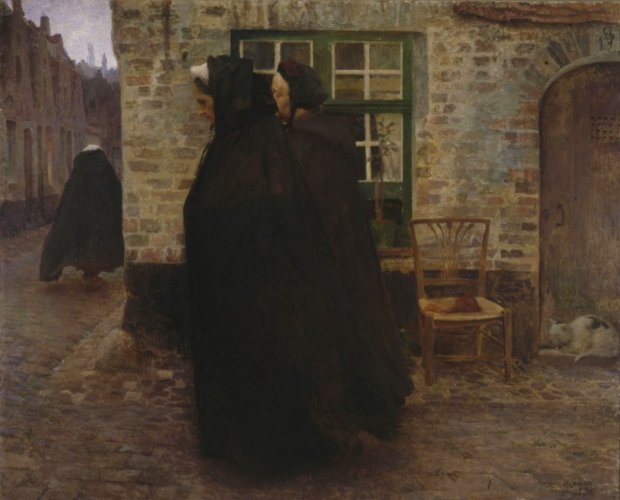Description:
Henri Paul Royer (1869–1938) was a French painter who graduated from the Académie Julian in Paris, where he later became a professor. He regularly exhibited his works, for which he was often awarded. In his art, he focused on genre painting, landscapes and portraits, as well as illustrations. His inspiration came from Belgian views, which he painted in a dark color scheme.
Description of the painting:
The painting “We Flandrii, wieczorem” depicts a fragment of everyday life of the Flemish. The foreground is occupied by two older women walking towards the left edge of the painting, shown in full figure from the side. The figures are dressed in dark, floor-length cloaks with hoods, from which only their pale faces can be seen. The facial expressions indicate that they are lost in their thoughts. Dynamics is introduced to the work by the movement of their cloaks, which move with their steps. The background of the figures is a view of an old brick building. At the right edge of the painting there is an entrance to it. The left part of the picture frame is occupied by the street leading into the town. A blurred row of houses and towers hidden in the fog is visible there. Following the street is another figure, shown from the back, dressed similarly to the women in the foreground. The cloak is blown, emphasizing the dynamics.
The painting is immersed in a gloomy aura. Maintained in browns and grays, it gives a somewhat dark impression. The blurred contour emphasizes the haze of space. The pavement on which the figures stand looks as if it were wet, which is characteristic of this region. The painting is a frame from the everyday life of the town. One can get the feeling that the theme of the work is passing away. This is evidenced by both the time of day, the age of the figures, and above all the elements visible in the background of the tenement house – a chair with a ball of wool and a cat. The artist suggests that they are as if the attributes of this stage of life. The composition of the figures may indicate that they are heading to an evening mass, which is a way of filling their time. The meaning of the work also refers to the moment when the work was created – the turn of the centuries. At this time, artists often dealt with subjects related to passing away.


